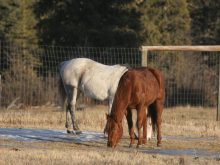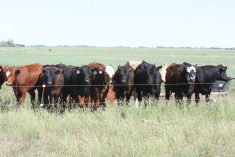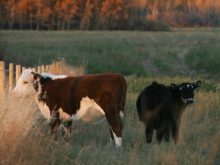Several years ago, when helping my uncle Walter sort through some DVDs, we came across a copy of A Bear Named Winnie, a CBC Television movie. He gave me the DVD and I watched it with awe.
This CBC production tells the true story of Canadian veterinarian Dr. Harry Colebourn. While I’d seen the images of horses from the First World War, I knew little about the veterinarians who cared for them.
Born in Birmingham, England, Dr. Colebourn immigrated to Canada as a young man and attended the Ontario Veterinary College. Following graduation, he took a position with the Department of Agriculture in Winnipeg. There, he joined the local militia as an officer. He enlisted in the early part of the First World War and became part of the Canadian Army Veterinary Corps.
Read Also

Growth plates are instrumental in shaping a horse’s life
Young horse training plans and workloads must match their skeletal development. Failing to plan around growth plates can create lifelong physical problems.
He was one of just 73 veterinary officers in the CAVC. About 800 individuals of other ranks also served in the CAVC, which represented just a fraction of the 640,000 Canadians who served in the war.
While traveling east to join the war effort, he bought a black bear cub at White River, Ont., which is about halfway between Winnipeg and Toronto. The bear would become their regimental mascot and it went to England with him. When he was deployed to the French front in December 1914, Dr. Colebourn took the bear to the London Zoo for safekeeping. There, author A.A. Milne took his son Christopher Robin to visit the bear and was inspired to write the classic children’s story, Winnie the Pooh.
Aside from showing the Canadian origins of an important piece of children’s literature, this film is remarkable for its depiction of the Canadian Army Veterinary Corps.
Before the First World War, horses played a pivotal role in military history. Imagine the abject terror one would feel when facing down a cavalry charge as a foot soldier, trying to hold the line. The charge of mounted soldiers, seeking to terrorize and overwhelm their opponents, had been a critical military strategy since the time of the Mongolian empire and its game-changing invention of the stirrup.
As depicted in the 2011 film War Horse, the cavalry charge was brutally rendered obsolete when facing modern machine gun fire. Although mostly removed from a direct role in battle, horses were still essential to the war effort. This included movement of supplies, heavy artillery weapons and ambulances. Supporting those horses were the army veterinarians, including the Canadians.
At one point in 1917, more than a million horses were in service on all fronts. An estimated half a million horses died in British Empire units alone.
Veterinarians advocated for basic husbandry such as the provision of food, water and rest. They treated injuries. And with that many horses assembled together, they also tried to control infectious diseases. Glanders, mange and influenza were some of these. Canadian veterinarians innovated the use of dipping baths to control highly contagious mange based on their experiences with sheep dips in the West.
Diagnostic tests and treatment options were limited compared to modern medical standards. No antibiotics existed to treat infections, no stretchy self-adhesive bandages were available to dress wounds, no sedatives were available to calm horses for treatment and no effective vaccines were available to prevent diseases.
Given the state of knowledge at the time, Canadian veterinarians were remarkably successful at treating the horses in their care.
According to the work of Dr. Lisa Cox and her online exhibit (www.thecanadianarmyveterinarycorp.com), 80 percent of horses they treated returned to active duty. And following the armistice, the Belgium government entered an agreement with the Government of Canada to buy all the Canadian army’s horses because they were in such good shape.
This Remembrance Day, let us not forget the contribution of this small but critical group of veterinarians to the victory in the Great War.
Dr. Jamie Rothenburger, DVM, MVetSc, PhD, DACVP, is a veterinarian who practices pathology and is an assistant professor at the University of Calgary’s Faculty of Veterinary Medicine. Twitter: @JRothenburger















